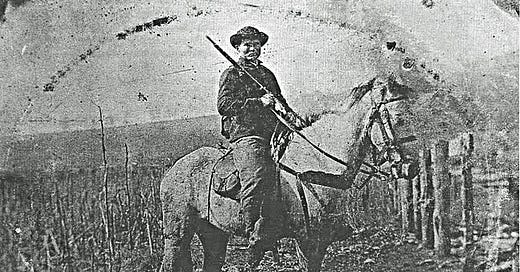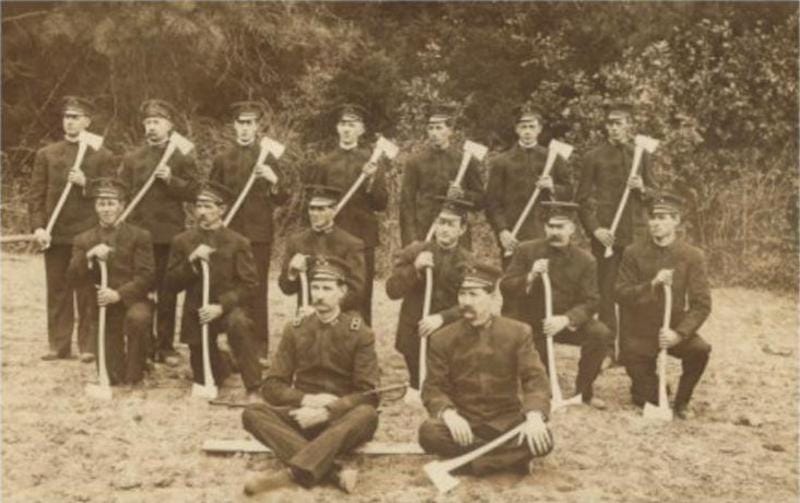Previous posts in this series: I, II, III, IV, V.
Recently, the New York Times reported Russian soldiers employing “swarm tactics” via e-scooters and ATVs in Ukraine.
These are actually dragoon tactics. Dragoon units are mounted infantry that arose in European armies in the early 17th century. Their defining feature is that they are infantry troops that have a personal mobility platform (initially the horse) that allows them to move more quickly than your regular line grunt, but they’re still trained to fight like infantry. It also allows rapid changes between dispersion and concentration, which is usually what people mean when they compare these tactics to swarming. In his lectures on small wars, a young Captain Carl von Clausewitz stressed the use of infantry and cavalry together, a task for which dragoons were ideal.1
Such units saw extensive use in the American Civil War. One prominent dragoon-like unit was Wilder’s Brigade (also known as the Lightning Brigade). Its commander, Colonel John T Wilder, outfitted the unit with horses, repeating rifles, and hatchets vice sabers. This enabled them to get places quickly, entrench, and disrupt and hold much larger Confederate forces in support of the more conventional army units. The first success of the unit was the Battle of Hoover’s Gap, part of the Tullahoma Campaign. Wilder’s Brigade went on to be very effective against Confederate irregulars, and against regulars at Second Chattanooga and Chicamauga. The Union also had success dismounting cavalry to fight as infantry, most famously those under Brigadier General John Buford on the first day of Gettysburg.
Dragoon tactics didn’t die with the obsolescence of horses in warfare. German bicycle battalions were employed during Operation Albion in 1917 where they rapidly seized and held key positions against the Russians in the early phases of the amphibious assault.2 By World War II, the motorcycle saw extensive use by most armies in the European Theater even as bicycle troops continued to see use. Japan employed roughly 50,000 bicycle troops when it invaded China in 1937.
So much for the past, but this is about the future. And the future holds a resurgence for dragoon tactics.
Keep in mind that a “dragoon” is an infantry troop with a personal mobility platform, be it a horse, a bicycle, a motorcycle, an ATV or now any manner of electronic conveyance like the Russian use of e-scooters.
The pervasive ISR and fires of the modern battlefield will demand rapid mobility and the ability to rapidly disperse and concentrate based on local conditions. In other words, the exact things dragoons have always been so good for.
The US military has already noticed. The Marine Corps and SOF as well as the Army have been experimenting with M-RZR all-terrain vehicles for a number of years, since well before Russia’s full-scale invasion of Ukraine in 2022. Although these vehicles carry more than one troop and therefore aren’t exactly fulfilling the definition of dragoons as infantry troops with individual mobility platforms, it seems likely that these experiments will continue and individual ATVs may see evaluation as well. As I’ve noted before, Wilder’s Brigade was one of the units that we looked at when putting together the ideas that became Force Design 2030. A highly-mobile unit with extra firepower can use that combination in both offense and defense against much larger but slower forces to devastating effect because it can switch between dispersal and concentration and offense and defense faster than the opponent. The Marine Corps isn’t there yet, but with the right mobility platforms and loitering munitions it can get there in the near future. Force Design was always designed to be an ongoing process through 2030 and the final shape is not clear yet.
Due to the need for rapid mobility on the modern battlefield and the easier sustainability of smaller platforms like ATVs, as well as the mobility downsides of expeditionary troops, it seems like a marriage between dragoon tactics and amphibious/airborne forces may be a match made in Valhalla.
Here, small war means, “the use of small units in the field. Battles of 20, 50, 100, 300 or 400 soldiers, as long as they are not part of a larger battle.” (From Clausewitz’s introductory notes to these lectures, page 21 of the linked Daase and Davis translation) He applied this term both to the skirmishing, recon, and screening actions of light troops in major wars and their use in what today we would call small wars or irregular warfare.
See Chapter Seven in On Contested Shores Volume 2.





Interesting discussion. In the 18th century the British after the series of wars with France introduced cost cutting measures to save money with its now peacetime army. One such measure was redesignating its cavalry regiments as dragoon regiments because under the practice of the times dragoons were paid less than cavalry men. However, the newly minted dragoons resented both the reduction in pay as well as in status and resolutely refused to dismount. This caused a lot of trouble when the army needed dragoons to face Napoleon but didn’t have any that could actually do the job. The US Cavalry fighting Native Americans found little use for cavalry tactics but dragoon tactics were essential. I’ve made the point since before the 2003 invasion of Iraq that ultimately everyone on the battlefield is potentially an infantryman or at least in your words a dragoon. The French Army of the 1840s and 1850s responded to the increased range of the new rifled muskets by adopting a faster march pace I order to cross the killing ground more quickly. It’s logical now that with the killing ground even bigger and much more lethal, we need now to develop mechanical assistance to get our infantry through the kill zone.
This is a great start off for a discussion! I think there is a debate to be had here between the various merits of leg, 'dragoon', mechanised, and armoured infantry. E.g. Does the greater mobility of bike-mounted 'dragoons' provide sufficient effect for the greater logistical burden compared to leg infantry? How does this compare to light mechanised infantry (e.g., transported in small lightly-armoured vehicles). How would they doctrinally fit into larger force structures?
I definitely think there is a place for small personal vehicles in airborne or amphibious units - I'd be interested to see what you might have to change doctrinally to accomodate them.
In general, I am very sympathetic to the idea of giving infantry a cheap way of lugging their kit around the battlefield without breaking knees/twisting ankles etc.